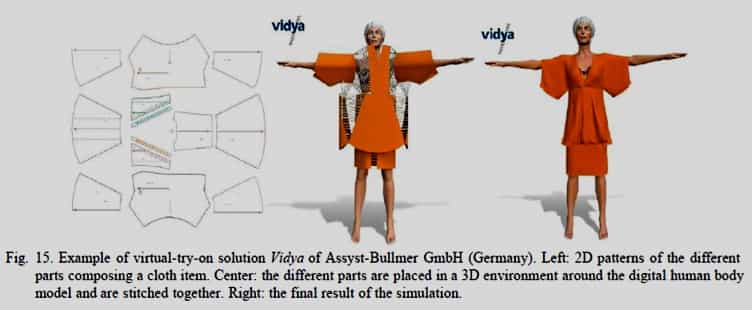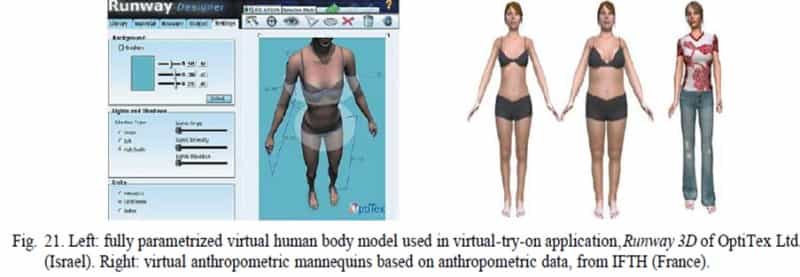3D Body Scanning
Anthropology and Sizing (APD)
Application of 3D Scanning in Apparel and Fashion Industry
Virtual Try-On
The so-called virtual-try-on solutions have gained importance in the last few years in different areas of the fashion industry. Virtual-try-on solutions simulate digitally the behavior of textiles onto the human body. In this way, they allow a virtual probe of cloth items onto digital human body models. 3D cloth simulation engines are employed to determine precisely how the cloth item will behave on the digital body model. The figure below shows an example of such solutions from Assyst-Bullmer.

The different parts of the textile defining a piece of cloth are described as 2D patterns (as is the case for usual CAD solutions employed in cloth manufacturing processes). For each part are specified all the required characteristics of textile, such as for example thickness or elasticity. The different parts are then placed in a 3D environment around a digital human body model and stitched together. The 3D cloth simulation engine will then determine the behaviour of the so formed cloth item over the human body model.

Various virtual-try-on solutions are available on the market. Modern and sophisticated solutions, as for example from OptiTexLtd Israel (Figure beside), allow to import of data from 3D scanning systems and simulate different poses of the human body model. Some of them allow additionally import motion information from previously recorded data. In this case, the behaviour of the textile is simulated dynamically.
In the case of virtual-try-on of eyewear, the benefits are manifolds for both customers and optical stores.
àFrom the point of view of the client: the unique high tech buying experience, the quick and easy way to select frames, the time saved on frame pre-selection, the possibility to share the frame selection with family and friends, the ability to see himself with new frames without lenses, the fast virtual try-on of new collections, and the private selection by Internet without obligation or embarrassment.
àFrom the point of view of the optical store: the augmented attractiveness of the store due to a unique purchasing experience, the reduced number of rejected frames due to accurate measurement, the saving on a stock by holding less frame inventory, the extended availability of a large collection of frames due to the virtual inventory, and the optician time saved by obtaining pre-selection of frames by the client.

Virtual makeover
Virtual makeover solutions deal with the virtual styling persons in the area of the face, by changing or adding virtually make-up, haircuts or accessories. The figures below show examples in hairdressing (by Stellure) and the Figures above show examples in accessorising (by Visionix). In both examples, the appeal of the human face is changed virtually by adding digitally to a digitized 3D human face, haircuts or glasses.

Size Surveying
Recently, human body size surveys have become a complete necessity.
All institutions and companies working on ergonomics are expecting information for practical immediate exploitation.
In fact, it had been realized that anthropometric data could improve the quality of product design and usability, workstation and workplace planning, and even labourer safety in certain environments. In the fashion industry, this information is used to tailor the size and shape of cloth items to the stature and body form of the actual population.

3D data required by size surveying: standard (legs, arms apart), standing and sitting postures, foot and hand.
National surveys have been initiated in the past in UK (SizeUK, 11’000 subjects scanned, 130 body measurements for each subject), in the USA (SizeUSA), but recently also in Sweden and in France. The standard posture used in all surveys features the legs and arms slightly apart of the human body, elbows and hand joints slightly bent. This allows an automatic determination of the important anthropometric measures of the human body (ISO7250). The most recent size surveys (Sweden and France) have added additional sitting and standing postures. New surveys launched in China also added the 3D measurement of hands and feet.

3D data required by size surveying: standard (legs, arms apart), standing different body sizes.
Anthropometric Mannequins
The anthropometric dummies represent exactly the conformations present in the population and assure that apparel collections are tailored to today’s customer stature and form. The figure below shows some examples of anthropometric mannequins. Different variations exist in the market regarding the form (fix mannequins, fully articulated), as well as regarding the employed materials. In some cases, special materials simulate the behaviour of soft tissue. 3D scanning technology can also be applied for the production of personalized mannequins. In this case, the anthropometric mannequin is built with regard to the measured sizes of a real person.

The most recent application of anthropometric mannequins resulted from the combination with virtual-try-on solutions. Virtual-try-on solutions are usually proposing fully parametrized general human body models, as for example from OptiTex(Figure below left). In this case, the user can modify the digital body model by changing different parameters. By introducing real anthropometric data, these models can be transformed into virtual anthropometric mannequins (Figure below right, from IFTH), offering the same advantages as the real anthropometric mannequins but in a virtual environment.

Made to Measure
The anthropometric dummies represent exactly the conformations present in the population and assure that apparel collections are tailored to today’s customer stature and form. The figure below shows some examples of anthropometric mannequins. Different variations exist in the market regarding the form (fix mannequins, fully articulated), as well as regarding the employed materials. In some cases, special materials simulate the behaviour of soft tissue. 3D scanning technology can also be applied for the production of personalized mannequins. In this case, the anthropometric mannequin is built with regard to the measured sizes of a real person.

The most recent application of anthropometric mannequins resulted from the combination with virtual-try-on solutions. Virtual-try-on solutions are usually proposing fully parametrized general human body models, as for example from OptiTex(Figure below left). In this case, the user can modify the digital body model by changing different parameters. By introducing real anthropometric data, these models can be transformed into virtual anthropometric mannequins (Figure below right, from IFTH), offering the same advantages as the real anthropometric mannequins but in a virtual environment.



